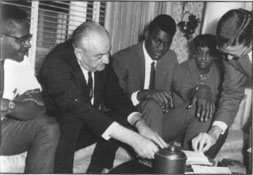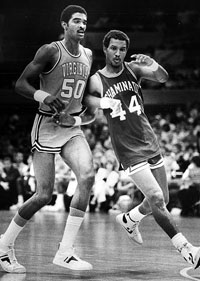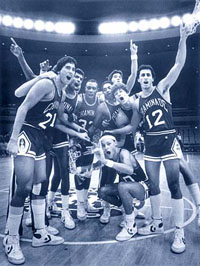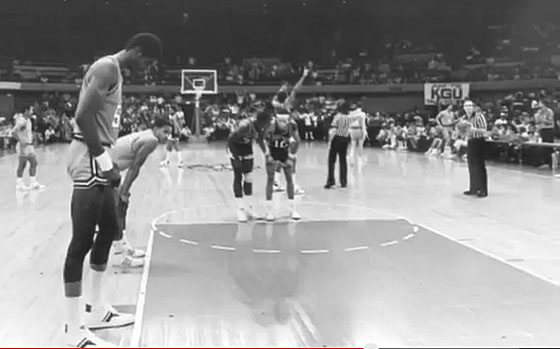|
Basketball
Snapshots - 5
Baron's
First Black Player
|
Tom
Payne was a 7'1" All-State senior at Louisville's
Shawnee High School. A lanky, easy-going kid, Tom
told reporters he loved to block shots. He wanted badly to play
for the major power in the state, the Kentucky Wildcats.
Only one problem. The year was 1968. Tom was African-American.
UK's coach was 70-year-old Adolph Rupp.
And in his 40 years in Lexington, "The Baron"
had never had a black player on his team. However, he recruited
Tom to be his first.
Payne's
parents paid his $2,000 tuition to attend Kentucky
his freshman year (1969-70) so that he could become academically
eligible to earn a basketball scholarship. The university had been
integrated for some time. In fact, black players had participated
in football and track. With a wife and infant daughter, Tom
made the grades to play his sophomore year.
Considered
a racist in many quarters and known to be very difficult on all
his players, Rupp did his best to shield Payne.
Vanderbilt had already
graduated an African-American player, and three other SEC schools
had black players. Nevertheless, the young giant faced tremendous
pressure. He endured vicious racial epithets during games at Ole
Miss, Mississippi
State, and Alabama.
Even at home games, his family overheard slurs from the Wildcat
fans. Despite the distractions, Payne had a good
year, averaging 16.9 ppg as UK won another SEC
championship during a 22-6 year. Tom scored 34
against Georgia and
39 against LSU. His
future looked bright. |
 |
But
behind the scenes, the picture was not so rosy. He had nine hours of incomplete
course work that would have to be made up to keep him eligible. And in
the summer of 1971, he was stopped for speeding in his new Cadillac. Having
been drafted by the Atlanta Hawks,
Payne decided to turn pro.
On
the morning he was to leave for Atlanta, police arrived at his home in
Louisville. A rape victim had identified him as her assailant after seeing
his picture in the newspaper. However, since the police report listed
her attacker as 6'3" and not 7'2," he was allowed to play the
1971-2 season for the Hawks,
where he averaged only 4.1 points in 29 games.
While
still in Georgia, he was arrested, convicted, and served five years on
rape charges. Then Kentucky authorities brought him back and prosecuted
him of the original rape charge. He served five years until paroled in
1983. He tried basketball again, then boxing, before moving to California
to become an actor. In 1986 LAPD caught him raping a woman. He was convicted
and sent to prison. Upon release in 2000, he was sent back to Kentucky,
where he returned to prison for 15 years for violating his parole.
|
"The Greatest Upset Never Seen"

Ralph Sampson and Tony Randolph

Sampson defends Ernest Pettway

Virginia-Chaminade action

Chaminade rejoices!
|
Something akin to Appalachian State beating Michigan in football
happened in basketball on December 23, 1982. The game didn't achieve the
instant notoriety of the Big House upset because it ended at 3 am Eastern
Time in faraway Hawaii. Rather than an audience of 108,000, the game was
seen by fewer than 4,000.
The Virginia Cavaliers, led by
7'4" Ralph
Sampson, were ranked #1.
- Partly as a ploy to convince Sampson
to return for another year, Virginia
scheduled a game in Japan against #2 Houston,
known as "Phi Slamma Jamma."
- On the return trip, the Cavs would stop in Hawaii to play Chaminade, an NAIA college
run by the Marianist Brothers with an enrollment of 900.
Before
the game in Japan, UVa met
Georgetown.
- The clash was billed
as "The Game of Decade" because of the matchup between Sampson and Patrick
Ewing.
- Ralph scored 23 with 16 boards and
7 blocks to spark the victory.
Then it was off to Japan for the three-team
Suntory Ball.
- Jet lag plagued the Cavs as they prepared to meet Houston,
led by Akeem Olajuwon, the other member of the triumvirate
of fantastic big men in college basketball that year.
- To make matters
worse, Sampson was not only dehydrated from the Georgetown game but also suffered from an intestinal virus. Even without him, the
Cavs beat Houston and then Utah to move to 8-0 for the season.
One
player recalled the team attitude at that point as "Oh yeah, there's
this little game in Hawaii, then we get home."
- The Chaminade
Silverswords had defeated Hawaii,
the Division I team in the state, but also had just lost at home to Wayland
Baptist, an NAIA team with a 5-9 record.
- Furthermore, Chaminade had been clobbered by Virginia each of the previous two seasons. And, most important of all, Sampson
would play in the game.
- Silverswords Coach Merv Lopes felt that, if we lost by anything less than 20 points to them, I would be happy.
Even
though the shot clock had not been implemented yet, the Silverswords did not hold the ball.
- Defensively they collapsed on big Ralph
to help their 6'6" center Tony Randolph
but otherwise played straight basketball.
- In fact, Chaminade took the game to the visitors from the opening tap, jumping to a 19-12
lead as Randolph moved outside to hit jump shots (9 of
12 for the game). This opened the middle for drives.
- Meanwhile, the travel-weary
Cavs were having a difficult
time hitting their shots (39% for the game). Nevertheless, they rallied
for a 43-43 deadlock at the half.
In the second stanza, Virginia seemed to take control, building a 56-49 lead.
- However, the plucky Silverswords
pulled even again to set up a nip-and-tuck finish.
- Trailing 74-72 in the
final minute, UVa was called for carrying the ball by one of the local officials, the Cavs'
25th turnover.
- Three FTs later, Chaminade won, 77-72.
- An ecstatic Lopes after the game: I just told my guys they had nothing to lose, so go out there and play, that is was an honor for a school like Chaminade to play the No. 1 team in the nation.

A weary Sampson waits for a FT |
The result caused confusion when transmitted to East Coast news outlets.
- Tom
Mees on ESPN's SportsCenter refused to read the score
until someone confirmed it by telephone.
- AP clients phoned the New York
headquarters asking if there's a misprint: Virginia Commonwealth?
Virginia Tech? Virginia
Union? Surely not Virginia.
- Chaminade's name was mispronounced by various anchors.
ChamiNADE (to rhyme with lemonade). Even Sha-MAN-da. (Actually, the school
had planned to change its name to the University of Honolulu
but backed off in light of the newfound fame.)
Shortly after the game, t-shirts were sold on the islands proclaiming YES,
VIRGINIA, THERE IS A CHAMINADE. The shirts were also popular at ACC
arenas that Sampson and Company visited that season.

Sampson at 2002 reunion of Chaminade Cinderellas YouTube presentation on the game
Reference: "The Greatest Upset Never Seen," Alexander Wolff, Sports
Illustrated, 12/31/07
|
History
of the Metro Conference
The
Metro Conference was formed in 1975 by six schools that did not belong
to any conference. The six charter members were
Cincinnati, Georgia
Tech, Memphis State,
Louisville, St.
Louis, and Tulane.
The name was chosen because all were city (metropolitan) schools. They
remained independent in football (with St.
Louis not fielding a gridiron team). The primary sport
for the new league was basketball because that same year the NCAA expanded
its basketball tournament to 32 teams and included at-large teams that
were not conference champs for the first time.
Changes
in conference makeup started immediately.
-
1976: Florida State joined
but remained independent for football.
-
1978: Georgia Tech left
for the ACC.
- 1979:
Virginia Tech joined.
- 1982:
Southern Mississippi
joined. St. Louis left
for the Midwest City Conference.
- 1983:
South Carolina joined.
- 1984-1989:
Tulane dropped its basketball
program as a result of a point-shaving scandal but remained a conference
member in all other sports.
- 1991:
Florida State left for
the ACC, South Carolina
joined the SEC, and Cincinnati
and Memphis transferred
to the Great Midwest Conference, another league that emphasized basketball.
UNC Charlotte,
South Florida, and Virginia
Commonwealth joined the Metro.
The
conference succeeded in its goal of becoming a force in basketball.
- Denny
Crum's Louisville Cardinals
reached five Final Fours in 11 years, with two national championships
(1981 and 1986).
- Memphis
made the Final Four in 1985.
- Basketball
attracted lucrative TV contracts and March Madness payoffs.
- The
Metro held a well-attended basketball tournament each season from 1976-1995.
As
football revenue began to dominate athletic departments' plans in the
early 1990s, the Metro tried to capitalize on the impending changes in
the NCAA landscape to expand and add football at the same time. The conference
held a two-day meeting with eight possible new members:
Boston College, East
Carolina, Miami,
Pittsburgh, Rutgers,
Syracuse, Temple,
and West Virginia. Miami
called the Metro a "viable option" that would unite them with
their in-state rivals, the Seminoles.
However,
two months later Louisville
football coach Howard Schnellenberger publicly opposed
conference affiliation for his sport, saying it would hamper his ability
to play a national schedule. He specifically wanted no part of a conference
with such lackluster football schools as Cincinnati,
Memphis, Tulane,
and Virginia Tech.
Another
blow came in September 1990 when FSU
announced it would join the Atlantic Coast Conference for all sports.
Then the Big East, one of the Metro's rivals in basketball, announced
it would start a football league that would include most of the schools
the Metro had targeted for expansion.
In
1995, what was left of the Metro merged with the Great Midwest Conference,
another conference that didn't sponsor football, to form Conference-USA.
A year later C-USA became a football league also, although a number of
members did not participate on the gridiron.
If
you followed all the comings and goings listed above, you will notice
that the only school that stayed in the Metro all 20 years of its existence
was Tulane.
|
|
CONTENTS
Baron's First Black Player
"The Greatest Upset Never Seen"
History of the Metro Conference
Basketball
Snapshots Index
Basketball
Page
Golden Rankings Home |






